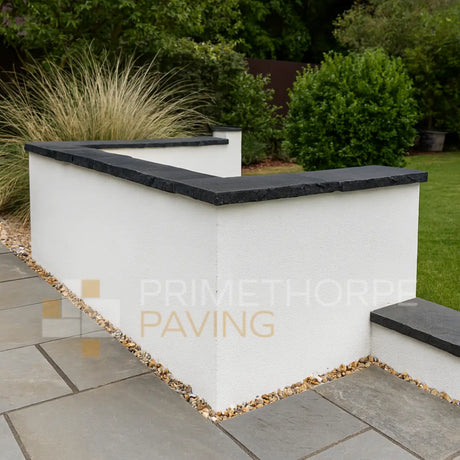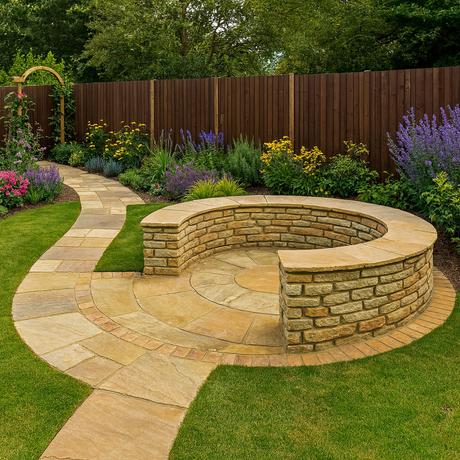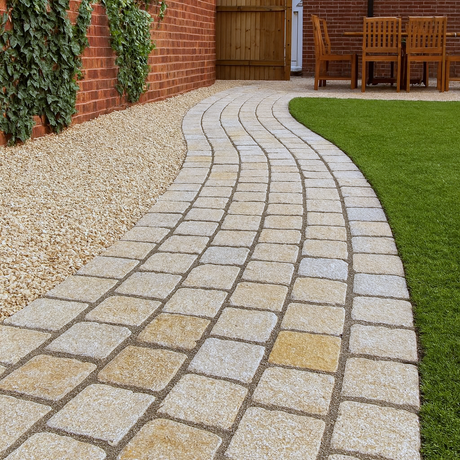If you have coping stones on your property, it's important to make sure that they are properly fixed in place. A mortar mix is the best way to do this. In this blog post, we will discuss the best mortar mix for fixing coping stones, as well as how to mix it and how use it. We will also provide a step-by-step guide on how to fix the copings to the top of your wall.
Key Takeaways:
- Ideal Mortar Mix: Use a three-to-one ratio of sand to cement for a strong bond. Avoid stronger mixes without a plasticiser to keep the mortar workable.
- Mixing Technique: Mix the mortar thoroughly to achieve a consistent, thick paste-like texture. Adjust with more sand, cement, or water as needed.
- Preparing the Wall: Ensure the wall is clean, dry, and level before applying mortar. Remove any plants and check for levelness to ensure a smooth installation.
- Installing Coping Stones: Spread mortar on both the wall and the coping stone's back. Place and tap the stones down with a rubber mallet, ensuring they are level and evenly spaced.
- Final Steps: After laying the stones, fill the joints with mortar and clean any excess. Allow the mortar to set completely, which may vary from 24 hours to a week depending on weather conditions.
What is a mortar mix?
A mortar mix is a mixture of cement, sand, and water. It is used to bind together bricks, blocks, and stones.
What is the best mortar mix for attaching wall copings?
There are different mortar mixes that can be used for attaching wall copings, but the best one to use is a three-to-one ratio of sand and cement. This mortar mix will provide a strong bond between the coping stones and the wall.
If you go for a stronger mix than a three-to-one ratio, the mix will become very difficult to work with and it becomes increasingly unlikely that you will be able to actually tap your copings into the mix itself. If you are going to go for something stronger, it is important to make sure that you use mortar plasticiser. This product softens the mortar and will ensure that the mortar does not become too hard and difficult to work with. Not to mention, the cost of the extra cement and plasticiser will hurt your pocket.
A weaker mix, such as a five-to-one or a six-to-one mix that some people choose when installing paving, presents its own difficulties. The mortar will be too runny and it will not provide a strong bond between the coping stones and the wall. Therefore, we recommend using a three-to-one ratio of sand and cement.
Now that we've gone over the best mortar mix for attaching wall copings, let's move on to how to mix it.
How do I mix a mortar mix?
There are a few steps to follow to give you the best chance of creating a good mortar mix nice and quickly:
Step 1. Add the sand and cement to a clean mixing bucket. The proportions should be three-to-one as stated above. The easiest way to measure these proportions is to simply scoop 3 shovels of sand for every 1 shovel of cement.
Step 2. Start adding water. Water will make up a significant amount of the volume of your mix. For every one-part sand & cement mix, you need to add approximately 4 parts of water. The water element isn't an exact amount, but it should be enough to help you create what feels like a "paste".
Step 3. Slowly add the water to the sand & cement, mixing constantly. The perfect mortar mix should resemble a thick paste. If it's too runny, add more sand and cement. If it's too dry and crumbly, add more water.
What is the best way to mix your ingredients?
Mixing your mortar can be tricky. It's not like dissolving sand and cement in water, it will be quite difficult to mix, so be ready to put a bit of a shift in. If you don't have a cement mixer (which not many of us do!) a large wheelbarrow is going to be your best friend.
Step 4. Add the ingredients in the above portions and then take out a large shovel, or a trowel. Slowly start mixing everything together, making sure to move the mortar around so that it doesn't set in one spot. Keep mixing and mixing. Imagine the rotations this mix would get in a cement mixer – you’ve got to recreate this amount of mixing with your hands. It is sadly not a quick job.
Step 5. Test your mortar. You'll know when the mortar is ready when it's a consistent colour throughout and has the same consistency as peanut butter. If it looks like cottage cheese or porridge, it needs to be mixed more. Once you think you have a good mixture, press into it with a trowel. It should live and leave indentations or ridges which stay in place.
When mixing mortar, it's important to get the proportions right, but ultimately it is not a precise science. It may take a bit of trial and error to get it exactly right. Just keep testing as you go and repeat Step 3 until you are happy.
Installing Your Copings with Your Mortar Mix
Once your mortar is made, the next bit should be a little easier. If your mix is just right, your coping stones should be easy to install.
Steps for installing your copings:
Step 1. First, look at the wall you're about to protect. Make sure that it is clean and dry, otherwise, your mortar mix will not adhere correctly. If there are any plants growing out of the wall, make sure to remove them.
Step 2. Next, using a spirit level or a long straight edge if you don’t have one, make sure that the wall is level. If it's not, your copings will be very difficult to get level after.
Step 3. Once you're happy that the wall is level, start spreading your mortar onto the top of the wall with a trowel. Also, add some to the back of the coping to give the mortar the best chance to adhere.
Step 4. Spread mortar over an area big enough to fit your coping stones. Add mortar to an area that is 25% bigger than the size of the coping you are installing so you have plenty of space to work with. The thickness of the mortar layer should be around 1-2cm.
Step 5. Now, start placing your coping stones into the mortar. Using a rubber mallet, tap each coping stone into place. Make sure to tap your coping stones down so that they are level with the wall and each other. A spirit level is incredibly important here. Check the coping stone is level by laying the spirit level across it, and then do the same with the coping next door to it to ensure they two are both level with each other.
Step 6. Leaving a 5-10mm space between copings. Fill the joints between the copings with the same mortar. If you get any mortar on the copings, quickly wash it off with a damp cloth. You don’t want to leave it on there for the risk of staining. There are a few guides out there that get into detail on exactly how to point coping stones if you want to look them up.
Step 7. Once all of the stones are in place, leave the mortar to set. This process can take anywhere from 24 hours to a week, depending on the weather conditions. In warm and dry weather, your mortar should set quite quickly. However, if it's cold or wet, it will take much longer for the mortar to set properly.
Step 8. Once the mortar has set, you can give the wall a final clean - if you have any excess mortar mix, remove it with a damp cloth - and your job is done!
Wall Copings Fixed With The Perfect Mortar
There you have it, a step-by-step guide to mixing the best mortar mix for coping stones as well as how to install them. We hope that this has been helpful and that your wall is now protected from the elements! Thanks for reading.
We have a full range of coping stones available if you are still searching. We have both limestone coping stones & sandstone coping stones available. It's especially worth checking out our black coping stones for a real feature piece. Please don't hesitate to get in touch if you have any further questions.






